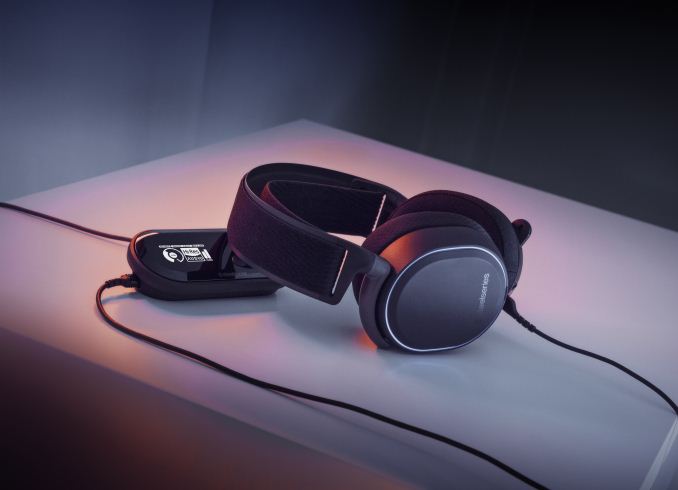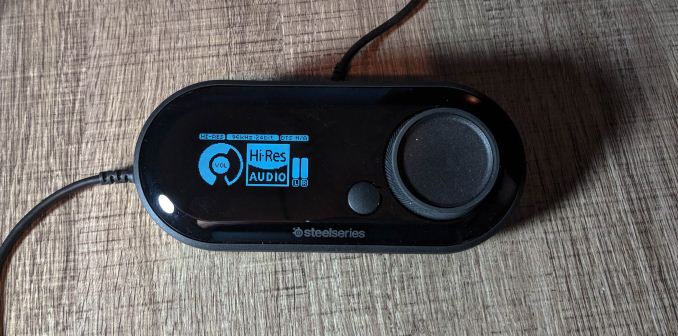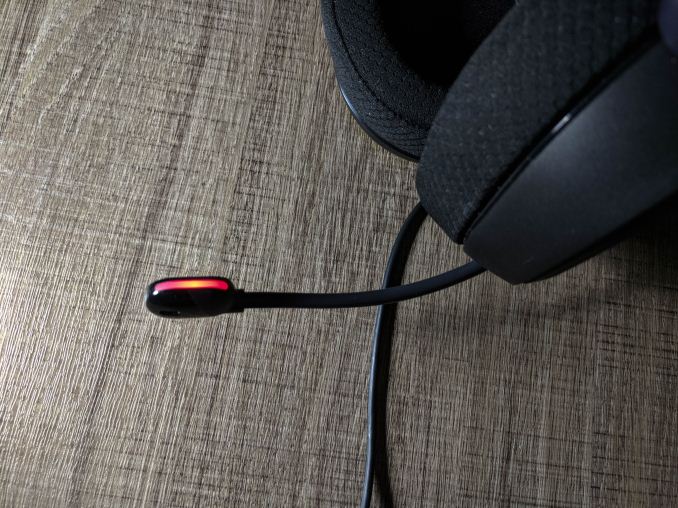The SteelSeries Arctis Pro Gaming Headset Lineup: GameDAC Or Wireless
by Brett Howse on March 13, 2018 9:00 AM EST- Posted in
- Headset
- Audio
- SteelSeries
- Accessories
- Arctis Pro

SteelSeries is a well-known manufacturer in the PC accessory space, and have been in the gaming headset market for some time. Today they are launching two new products at the top of their Arctis lineup, and both of them offer some interesting new features. The first is the Arctis Pro + GameDAC, which is the first Hi-Res Certified gaming headset on the market. The second is the Arctis Pro Wireless headset, which takes many of the features of the wired model, and adds wireless to the mix. We see a lot of accessory announcements, but when SteelSeries briefed us on these two new headset models, there was a lot of interesting technology they were bringing to the table, which is always something to get excited about.
The Arctis Pro + GameDAC is really the star of the show. SteelSeries has recognized that the majority of people use onboard audio, and although a few motherboards do ship with high quality audio components, the majority do not. SteelSeries has an answer to that problem with the GameDAC, which is a USB DAC (Digital to Analog Converter) and amplifier which has been tuned specifically for the Arctis Pro headset. We’ll dig into the GameDAC in a bit, but there’s a lot to like here.
Both the Arctis Pro wired and wireless model both feature the same drivers, which SteelSeries has said are the highest quality drivers they’ve ever used in a gaming headset. They feature neodymium magnets, and can produce frequencies from around 10 Hz to 40,000 Hz, which you’ll notice is both well below and well above the thresholds for human hearing. This gave them some flexibility in tuning the response.
| SteelSeries Arctis Pro Lineup | |||||
| Component | Arctis Pro + GameDAC | Arctis Pro Wireless | |||
| Compatibility | PC and PlayStation 4 | ||||
| Speaker Drivers | 40 mm Neodymium | ||||
| Headphone Frequency Response | 10 Hz to 40 KHz | ||||
| Headphone Sensitivity | 102 dBSPL | ||||
| Headphone Impedance | 32 Ohm | ||||
| Headhone THD | < 1% | ||||
| Microphone | Bi-directional noise cancelling | ||||
| Microphone Frequency Response | 100 Hz to 10 KHz | ||||
| Microphone Sensitivity | -38 dBV/Pa | ||||
| Microphone Impedance | 2200 Ohm | ||||
| Audio Formats | Hi-Res Certified 24-bit 96 KHz | 16-bit 44 KHz Bluetooth 4.1 A2DP, HFP, HSP |
|||
| THD + N | < 0.0032% | Not Rated | |||
| Box Contents | Arctis Pro Headset GameDAC Main Headset Cable USB Audio Cable Toslink Optical Cable 4-Pole 3.5mm adapter Microphone Windscreen |
Arctis Pro Wireless Headset Transmitter Base Station USB Audio Cable Toslink Optical Cable Mobile Audio Cable Mobile Charging Cable Microphone Windscreen |
|||
| Price | $179.99 Headset Only $249.99 Headset and GameDAC |
$329.99 | |||
SteelSeries officially promotes the Arctis Pro models as headsets that work on both the PC and the PlayStation 4. Xbox will work with audio only. Both models do come with a 3.5mm headset adapter as well, for connection to almost anything, and assuming you have a newer model Xbox One controller, this would also provide full headset capabilities.
SteelSeries also offers the ClearCast microphone on both of the Arctis Pro headsets we’re looking at today. ClearCast is a bidirectional microphone setup which offers active noise cancellation. With a bidirectional microphone, noises that are heard on both sides of the microphones can be cancelled out, since they are likely background noises, which leaves your voice stronger and clearer, without sounds from outside that window having much of an impact on the sound recording. In practice, this setup is very effective. Sounds from the keyboard are muted, and noises further away are completely eliminated.
SteelSeries is replacing their older Siberia 800 and 840 models with these new ones, and will be offering three combinations. You can get the Arctis Pro headset only, the Arctis Pro + Game DAC combo, and the Arctis Pro Wireless. These aren’t inexpensive headsets, but neither are they the most expensive models around. But to see if they are worth the asking price, we first must check out how they fared in the couple of weeks of testing.












32 Comments
View All Comments
jimjamjamie - Tuesday, March 13, 2018 - link
So is this an advert or..?Stuka87 - Tuesday, March 13, 2018 - link
Pretty much every product a site like AnandTech reviews is given to them by the company that makes the product, but it doesn't read like an advertisement. It reads like a review that describes the product.Dr. Swag - Tuesday, March 13, 2018 - link
This doesn't feel like a review, but an announcement article, hands on, or advert.jordanclock - Tuesday, March 13, 2018 - link
I mean, it goes over the features, critiques them and then presents an opinion on the product. Sounds like a review to me.jordanclock - Tuesday, March 13, 2018 - link
But I will admit that this review doesn't seem very comprehensive. It's a lot of subjective assessment and the only objective measurement comes from the vendor.Samus - Tuesday, March 13, 2018 - link
I fail to see a real improvement over the Siberia 800. In fact, some aspects feel like a downgrade, particularly the lack of user replaceable\swappable batteries.One of the main selling points of the Steelseries H (which I own, predated the Siberia but is the same thing) was that it included two batteries and the base could charge one while the other was in use.
Samus - Tuesday, March 13, 2018 - link
Ahh, after actually reading the review and not just the first page, I see the Arctis Wireless does include two batteries and resembles the Siberia 800. I don't really see a difference other than the subjectively different driver tuning...Brett Howse - Tuesday, March 13, 2018 - link
Always read past the first page!These are a replacement for the Siberia 800 and offer better drivers. Siberia was 20-20Khz these are 10-40Khz. Plus the updated band from the Arctis lineup.
we - Thursday, March 15, 2018 - link
One thing irritated me somewhat while reading was that you seem to be giving the impression that headset frequency response is the primary indicator of headset sound quality, which is somewhat misleading. You can have two headphones, both with an excellent and just about identical frequency response, that sound very different, and one may even sound downright awful. A headphone with a mediocre frequency response may even sound better than one with an "ideal" on-paper frequency response. There are various reasons for this. One is that companies don't necessarily measure frequency response in the same way. Another is diaphragm linearity and break up. A cheap diaphragm may have excellent frequency response measured with a simple sine-wave sweep. But if it has to concurrently deal with strong bass tones and high frequency harmonics, the bass tones may push the the diaphragm outside of its most linear and most stable operating range, and as a result the HF tones may audibly suffer. You can't detect this kind of behaviour with typical frequency response measurments. Things like intermodulation distortion, driver linearity and break-up, damping and resonance characteristics of the transducer, its components and its housing can seriously influence subjective sound quality. Of course everything else being equal, the headphone with the better frequency response will outperform the one with a poorer frequency response. (I am not saying there is anything wrong with the headset tested. It may well be excellent, and apparently much thought has been invested in attaining high quality sound. In all probability, the designers know very well that a decent frequency response should be a given at this price point, and is only one of many aspects of design that have to be carefully considered to create a good headset)Brett Howse - Saturday, March 17, 2018 - link
It's not just frequency response, but that's a bit factor on these if you look at the graph. These don't have the boominess you'd see in some headsets where the bass response peaks at 60-100Hz and falls off drastically from there.